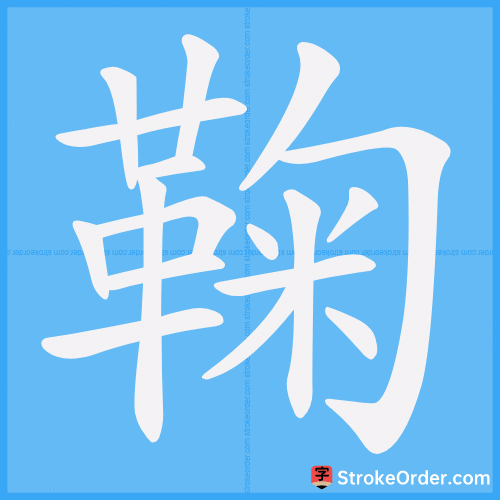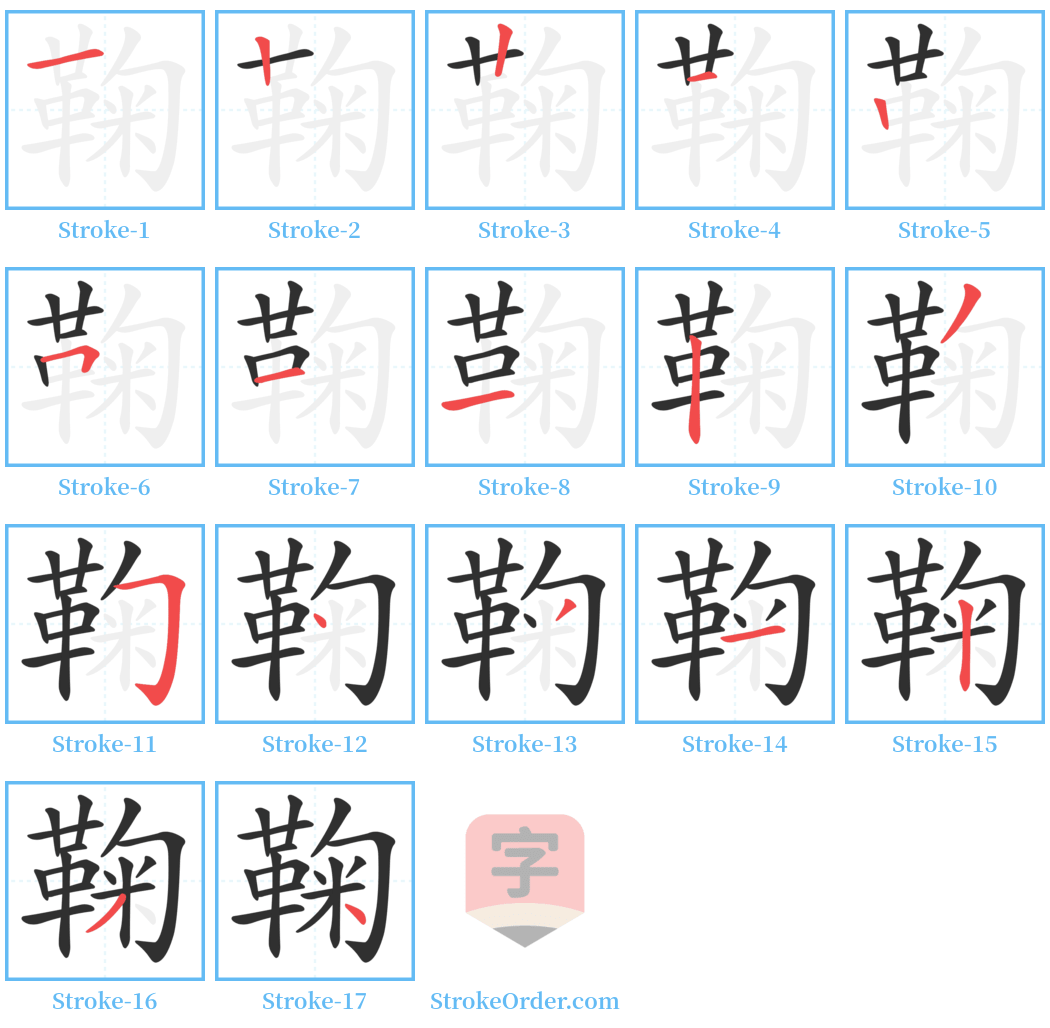鞠 Stroke Order
Animated Stroke Order of 鞠

Stroke Order Diagrams for 鞠

Step-by-Step Handwriting Guide for 鞠

Learn to Write Chinese Characters with Video Tutorials
Watch the video of writing the Chinese character "鞠", learn the correct stroke order (笔顺) of the character "鞠", and master the standard way of writing the character "鞠".
Free Printable Handwriting Practice with Stroke Order: 鞠
Printable Writing Practice Worksheet of "鞠" in Portrait Orientation (Tian Zi Ge)

Printable Writing Practice Worksheet of "鞠" in Landscape Orientation (Tian Zi Ge)

Information of 鞠
Pinyin
jū
Radical
革
Strokes
17 strokes
Usage
★★★★★
Definition
to bring up / to rear / Ju (a surname)
鞠
[jū]
名
1. 养育,抚养。
[En.] To nurture, to rear.
2. 弯曲。
[En.] To bend.
3. 大,穷极。
[En.] Great; extreme.
4. 幼小。
[En.] Small; juvenile.
5. 穷困。
[En.] Poverty.
6. 告诫。
[En.] To warn.
7. 古代的一种皮球。
[En.] A type of leather ball used in ancient times.
8. 姓。
[En.] Surname.
动
1. 弯曲,弯身。
[En.] To bend; to bow.
2. 通“育”。抚养;生育。
[En.] To give birth to; to rear.
3. 匐匍。
[En.] To crawl.
4. 爱。
[En.] To love.
5. 通“鞫”。审讯或审查。
[En.] To interrogate.
6. 告诫,警告。
[En.] To warn.
引
1. 《说文》:鞠,蹋鞠也。
[En.] "According to the Shuowen Jiezi: '鞠' refers to a leather ball."
2. 蹋鞠黄帝所作或曰起战国时。—— 贾谊《新书》注
[En.] "蹋鞠 was created by the Yellow Emperor, or perhaps started during the Warring States."
3. 《史记·卫将军传》:穿域蹋鞠。
[En.] "穿域蹋鞠." Yang Xiong’s commentary: “The ball is made of leather and filled with fur, used for play.”
例
又如: 鞠室(蹴鞠之所); 鞠场(毬场); 鞠戏(古代踢球的游戏); 鞠院(古球场,有围墙)。
[En.] For example: 鞠室 (a place for kicking the ball); 鞠场 (ball court); 鞠戏 (ancient ball games); 鞠院 (ancient ball court, enclosed).
形
1. 幼小、幼稚。
[En.] Young; immature.
2. 皮毬,一种以皮革缝合,内塞以鸟羽等柔软物或充气而成的球。
[En.] A ball made of leather sewn together, filled with feathers or soft materials, or inflated.
-- Citation from "资治通鉴".
3. 菊花。
[En.] Chrysanthemum.
4. 姓。如宋代有鞠常。
[En.] A surname, for example, there was a person named 鞠常 in the Song dynasty.
动
1. 养育、抚育。
[En.] To nurture and raise.
2. 弯曲。
[En.] To bend.
3. 审问。
[En.] To interrogate.
4. 穷困。
[En.] To be in poverty.
引文
《诗·小雅·蓼莪》:“父兮生我,母兮鞠我。”
[En.] "In the Book of Songs: 'Father gave me life; mother nurtured me.'"
例
如: 鞠养(抚养); 鞠育(教育抚育)。
[En.] For example: 鞠养 (to rear); 鞠育 (to nurture and educate).
5. 通“鞫”。审讯或审查。
[En.] To interrogate or examine.
例
如: 鞠理(审理); 鞠治(问罪)。
[En.] For example: 鞠理 (to examine); 鞠治 (to interrogate).
6. 告诫,警告。
[En.] To warn.
引文
《诗·小雅·采芑》:“陈师鞠旅。”
[En.] "In the Book of Songs: 'The troops are arranged, and warnings are given.'"
例
如: 鞠凶(告凶,预示灾祸)。
[En.] For example: 鞠凶 (to forewarn of misfortune).
Input Method for 鞠
Pinyin
ju1
Wubi
afqo
Cangjie
tjpfd
Zhengma
eeru
Four Corner
47520
Unicode
U+97a0
Same Pronunciation Characters